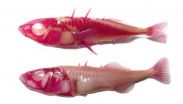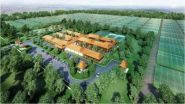(Press-News.org) From the most parched areas of Saudi Arabia to water-scarce areas of the western U.S., the idea of harvesting fog for water is catching on. Now, a novel approach to this process could help meet affected communities' needs for the life-essential resource. Scientists describe their new, highly efficient fog collector, inspired by a shorebird's beak, in the journal ACS Applied Materials & Interfaces.
Cheng Luo and his doctoral student, Xin Heng, explain that deserts and semi-arid areas cover about half of the Earth's land masses. In some of these places, trucks bring in potable water for the people who live there. To find a more sustainable way to get water, these communities, which can't draw water from underground or surface supplies, have turned to the air — and to nature for inspiration. They implement methods adapted from those that desert beetles, cacti and grasses use to catch water from the misty fog when it rolls in. But existing techniques require complicated, costly processes or collect only a small fraction of the water that fog has to offer. For new ideas, Luo's team turned to shorebirds with long, thin beaks.
By opening and closing their beaks, shorebirds drive food-containing liquid drops into their throats. The researchers mimicked this phenomenon by building simple, fog-collecting, rectangular "beaks" out of glass plates connected by a hinge on one side. When open, the plates provide a large surface area where beads of fog condense. When the plates close, then re-open, the droplets slide toward the hinge and into a collection tube. A single 10-inch by 4-inch prototype "swallowed" about a tablespoon of water in 36 minutes. Over two hours, it harvested 400 to 900 times more water than both natural and other artificial fog-collectors.
INFORMATION:
The American Chemical Society is a nonprofit organization chartered by the U.S. Congress. With more than 161,000 members, ACS is the world's largest scientific society and a global leader in providing access to chemistry-related research through its multiple databases, peer-reviewed journals and scientific conferences. Its main offices are in Washington, D.C., and Columbus, Ohio.
To automatically receive news releases from the American Chemical Society, contact newsroom@acs.org.
Follow us: Twitter Facebook
Artificial 'beaks' that collect water from fog: A drought solution?
2014-09-17
ELSE PRESS RELEASES FROM THIS DATE:
Parts of genome without a known function may play a key role in the birth of new proteins
2014-09-17
Researchers in Biomedical Informatics at IMIM (Hospital del Mar Medical Research Institute) and at the Universitat Politècnica de Catalunya (UPC) have recently published a study in eLife showing that RNA called non-coding (IncRNA) plays an important role in the evolution of new proteins, some of which could have important cell functions yet to be discovered.
Ribosomes produce proteins from the instructions found in an RNA molecule. However, only 2% of the human genome is RNA containing information for the synthesis of proteins, meaning it is coding. Other parts of the ...
Iberian pig genome remains unchanged after 5 centuries
2014-09-17
A team of Spanish researchers have obtained the first partial genome sequence of an ancient pig. Extracted from a sixteenth century pig found at the site of the Montsoriu Castle in Girona, the data obtained indicates that this ancient pig is closely related to today's Iberian pig. Researchers also discard the hypothesis that Asian pigs were crossed with modern Iberian pigs.
The study, published in Heredity, sheds new light on evolutionary aspects of pig species, and particularly on that of the Iberian breed, considered to be representative of original European Mediterranean ...
Smoke wafts over the Selway Valley in Idaho
2014-09-17
Smoke from the fires in the Selway Complex is wafting into the Selway River valley in this image taken by the Moderate Resolution Imaging Spectroradiometer (MODIS) aboard the Terra satellite on September 15, 2014. Actively burning areas, detected by MODIS's thermal bands, are outlined in red. All the fires began between August 10 and August 25, 2014 by lightning strikes. The following fires are part of the Selway Complex: Raven Creek, Elevator Mountain, Eagle Creek, Vance Mountain, Nick Wynn, and Jerusalem fires.
The Johnson Bar fire is also contributing to the smoke ...
Slimy fish and the origins of brain development
2014-09-17
Lamprey—slimy, eel-like parasitic fish with tooth-riddled, jawless sucking mouths—are rather disgusting to look at, but thanks to their important position on the vertebrate family tree, they can offer important insights about the evolutionary history of our own brain development, a recent study suggests.
The work appears in a paper in the September 14 advance online issue of the journal Nature.
"Lamprey are one of the most primitive vertebrates alive on Earth today, and by closely studying their genes and developmental characteristics, researchers can learn more about ...
Improved risk identification will aid fertility preservation in young male cancer patients
2014-09-17
(MEMPHIS, TENN. – September 16, 2014) A study led by St. Jude Children's Research Hospital investigators has found the chemotherapy dose threshold below which male childhood cancer survivors are likely to have normal sperm production. The study appears in September 17 edition of the journal Lancet Oncology.
By clarifying which patients are at highest risk for reduced sperm production as adults, researchers expect the findings to eventually increase use of pre-treatment fertility preservation methods such as sperm banking.
The study involved drugs called alkylating agents ...
The rich have more political clout in states, but stricter lobbying rules can narrow gap
2014-09-17
State legislators are more attentive to wealthy citizens' political opinions compared to poor citizens' opinions when making policy decisions, but stricter regulations on professional lobbyists can promote more equal political representation, according to a Baylor University study.
"Stricter lobbying laws are an important tool for ensuring that citizens' opinions receive more equal consideration when elected officials make important policy decisions," said researcher Patrick Flavin, Ph.D., assistant professor of political science in Baylor's College of Arts & Sciences.
The ...
Counting fish teeth reveals regulatory DNA changes behind rapid evolution, adaptation
2014-09-17
Sticklebacks, the roaches of the fish world, are the ideal animal in which to study the genes that control body shape. They've moved from the ocean into tens of thousands of freshwater streams and lakes around the world, each time changing their skeleton to adapt to the new environment.
Breeding studies between marine and freshwater populations of sticklebacks now have turned up one of the genes that controls tooth number, plus evidence that a simple change in that gene's regulation in a freshwater population is associated with a near doubling in the number of teeth. ...
Smart teens rub off on teammates
2014-09-17
A new study of high school activities bears this message for incoming high school students: Play what the smart kids play.
Joining an extra-curricular team or club with members that get good grades can double a high school student's odds of going to college.
And Brigham Young University sociologist and study co-author Lance Erickson knows how to sell the study to teens.
"Tell your parents, whatever they ground you from, it shouldn't be from practice or a club activity," said Erickson. "If they ground you from a school club, you are more likely to end up living at ...
Being social: Learning from the behavior of birds
2014-09-17
VIDEO:
In this Science Minute from NIMBioS, Dr. Elizabeth Hobson explains what monk parakeets can teach us about complex sociality.
Click here for more information.
KNOXVILLE—Science has learned a great deal about complex social behavior by studying nonhuman mammals and primates, but parrots might have something to teach too.
With their unusually large brains relative to their body size and advanced cognition, parrots live in a complex social environment---not merely in ...
Malaysia's 'Smart Villages' and 9 other proven ideas for sustainable development
2014-09-17
As nations zero in on the UN's post-2015 global Sustainable Development Goals, innovations being successfully pioneered and demonstrated in Malaysia offer several proven tactical ideas for improving the world, says an influential international sustainable development networking organization.
The UN's Sustainable Development Solutions Network (SDSN), through its Malaysian chapter, cites ways in which the country is "rising to the challenge," including the construction of ingenious, self-sustaining "smart" villages -- each lifting about 100 families out of poverty and ...




